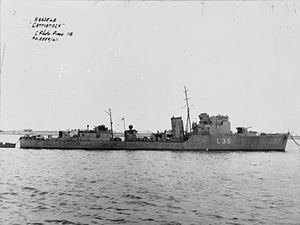Name HMS Cattistock Completed 22 July 1940 Decommissioned 26 March 1946 Launched 22 February 1940 Draft 3.28 m | Laid down 9 June 1939 Commissioned 22 July 1940 Construction started 9 June 1939 Length 85 m | |
 | ||
Namesake A fox hunt in Dorsetshire, England | ||
HMS Cattistock (L35) was a Type I Hunt-class destroyer of the Royal Navy. She was a member of the first subgroup of the Hunt class and served throughout World War II before being scrapped in 1957.
Contents
Construction and Commissioning
Cattistock was ordered from Yarrow in the 1939 Build Program and laid down on 9 June 1939 as No. J1834. She was launched on 22 February 1940 and commissioned on 22 July 1940, Lieutenant Commander Robert Ewing in command.
Career
After her commissioning in July 1940, Cattistock performed convoy escort duties in the North Sea from then to June 1941. She was detached for the bombardment of Dieppe with HMS Quorn and HMS Mendip on 26 July 1942. After the failure of the raid, where she was slightly damaged, Cattistock resumed convoy escort duties. In May 1944, Cattistock became part of Force G in preparation for Operation Neptune. During the landings, she escorted Convoy G1, which was composed of minesweepers. After arriving at the beaches, she deployed off Gold Beach, where she provided gunfire support. Cattistock conducted convoy escort duties off Normandy and switched to patrols against E-boat attacks in July 1944. On 7 July 1944, she sustained slight damage after an E-boat attack.
Cattistock steamed to Portsmouth for boiler tube replacement. She resumed patrol duties on 24 August 1944. On 29 August 1944, she intercepted German naval forces attempting to escape Le Havre while patrolling with HMS Retalick. In this action, she was hit 26 times. Her captain, Lieutenant Richard Keddie was killed along with four other men and about 25 men were wounded. As a result of the severe damage suffered, she returned to Portsmouth for repairs.
After three months of repairs, Cattistock resumed convoy escort duties. On 2 February 1945, she may have destroyed a German midget submarine off Zeebrugge. In August 1945, Cattistock was transferred to the Portsmouth Local Flotilla and was paid off on 26 March 1946. She was sold for scrap after ten years in reserve in 1957. In June 1957 she arrived at the breakers yard of John Cashmore Ltd at Newport, Wales for breaking up.
